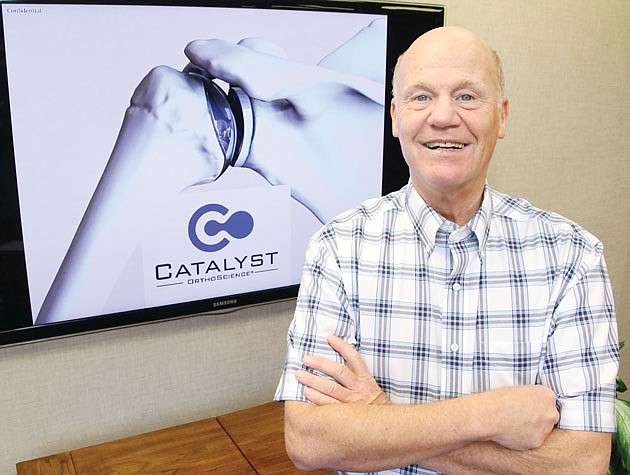- October 16, 2024
-
-
Loading

Loading

A Naples maker of an artificial shoulder has capped a strong year of market growth with $3 million in new investment capital to match a $3.3 million raise in 2016.
The company, Catalyst OrthoScience, will put a third of the new funds into increasing its inventory of the shoulder replacement device developed by Naples orthopedic surgeon Dr. Steven Goldberg. The remaining funds will go toward marketing, refining Goldberg's device and developing new related orthopedic devices, says Robert Kaufman, a veteran medical device industry executive who joined Catalyst OrthoScience as chairman last year. Kaufman was named CEO in August.
Through fall 2016, slightly more than a dozen implants of the shoulder arthroplasty device had been completed. Most of those operations were done by Goldberg, a Columbia University-trained physician and chief of the Division of Orthopedic Surgery at Physicians Regional Healthcare System in Naples. Little more than a year later, Goldberg and other orthopedic surgeons nationwide have done more than 300 device implants.
The medical benefits of the device, contend Catalyst OrthoScience officials, is its slim size and a design that keeps much of the patient's anatomy in place. The size and design eliminates the need to cut too much of the patient's bones, muscle and ligaments.
Still, getting notice for the device took tireless networking, meeting with doctors and attending conferences, Goldberg says. His message: The Catalyst OrthoScience product — made in Warsaw, Ind., with biomaterials consisting of advanced metals and plastics — is less evasive, closely replicates the joint's natural movement and is more efficient for the surgeon and patient.
“Most doctors are very interested immediately when we show them the technology. They tell us, 'This makes a lot of sense,'” says Goldberg, Catalyst's founder and chief medical officer.
In addition to networking in the medical community, Catalyst OrthoScience officials have to showcase the company to potential investors. Roughly 10% of the new $3 million round of financing came from the Tamiami III fund, a new incarnation of the Naples-based angel fund that put $930,000 into Catalyst last year as Tamiami II. Another $2.37 million came from various investors that included a Chicago investment group made up of Notre Dame alums and others with ties to the university.
Last year was Tamiami's first investment in an early-stage life sciences company. The organization, says chairman Timothy Cartwright, had confidence in the team and product, and it helped that Goldberg gained U.S. Food and Drug Administration approval and a patent for the device before he approached investors. “This is really an injection of capital” to keep up with demand from surgeons and to meet growth potential, Cartwright says.
The IrishAngels accounted for a 7% share of the remaining new funds and much of the rest came from individuals. A half dozen or so are surgeons who have been implanting the artificial shoulder, says Kaufman. The mix included previous investors and up to 14 new ones, he adds.
Kaufman says the latest funds will help increase sales in new markets of Boston and Washington, D.C., which have been stronger than expected. Close to 30 doctors are doing the implants now, says Cartwright.
While Catalyst works on the now, executives and investors keep a close eye on the future — namely an exit strategy. Kaufman says several big medical device companies that seek to buy Catalyst have come knocking. The answer — so far — is no. “They know we're not for sale,” says Kaufman. “They could offer anything now and (we) wouldn't sell.”
That could change, and executives and investors believe it will, in two to four years. By then, Cartwright hopes Catalyst will be at break-even or even profitability, without taking on a venture fund investment.
“The longer you wait, hopefully, the bigger (Catalyst) becomes from an earnings or valuation perspective,” Cartwright says. Then, when it's sold, “that will be the day everybody cheers.”
(This story was updated to reflect the sources of the $2.7 million funding part of the overall investment.)